By Eric Vandenbroeck and co-workers
Hitler's
Aristocrats
King Edward VIII, subsequent Duke of Windsor, told his friend Diana
Mosley, the wife of the British Fascist leader, Sir
Oswald Mosley, that ‘every drop of blood in my veins is German’ was
initially influenced by his family members among the German aristocracy, which
also led to Hitler's idea of an Anglo-German collaboration.
Contrary to the conventional history of a country united in opposition
to Hitler, right-wing British MPs, Peers, and senior figures in the military
clandestinely worked – individually and collectively – to hasten a German
victory and to supplant the elected British Government with a pro-Nazi puppet
regime which if up to Hitler would be a re-instated King Edward VIII.
Creating some furor in July
2015 was:

The current Queen
Elisabeth, then a seven-year-old princess as pictured, gave a Nazi salute in
1933.
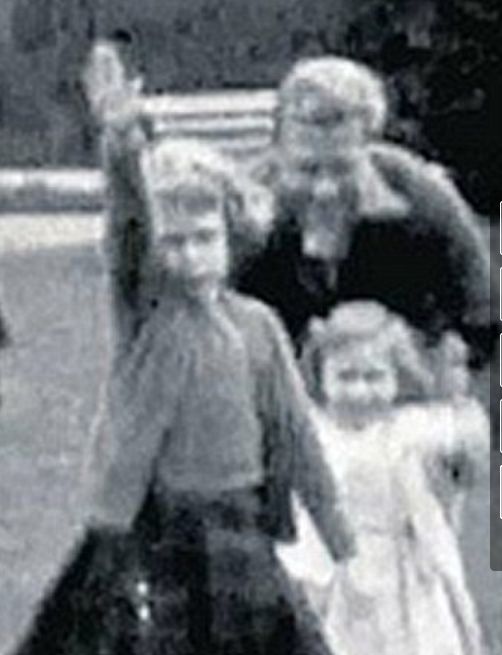
Below King Edward VIII, now the Duke of
Windsor with Nazi salute:
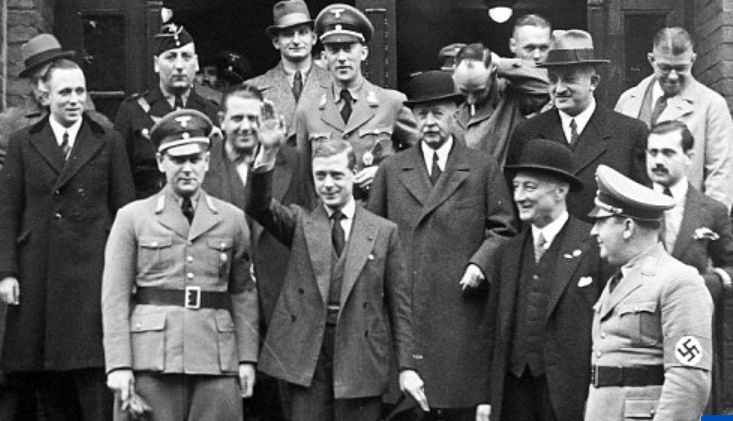
Below is the son of the former
Kaiser Wilhelm II, Prince August Wilhelm, in Nazi uniform
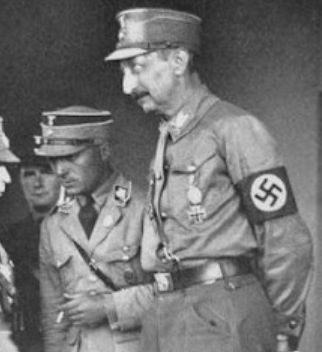
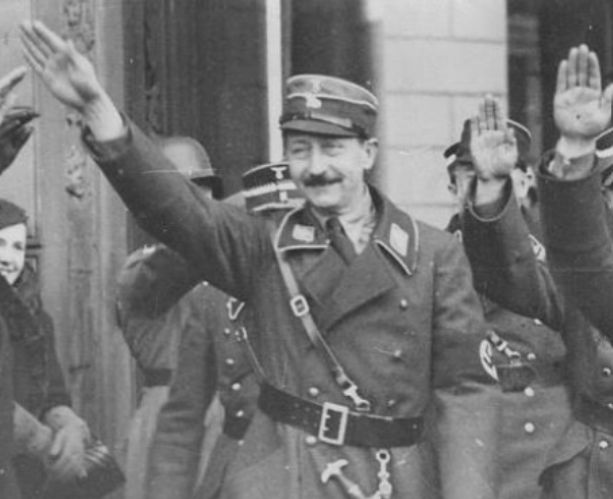
In 2017 a subject that
briefly drew the general public's attention was the sixth episode of The
Crown’s second season titled Vergangenheit,
named for the German word for past. The creator of the series and its
writer, Peter Morgan, is a skilled romancer of events and characters. But in
this impeccably staged pageant of the life and testing times of the House of
Windsor, there was one piece of air-brushing that needed more attention than it
had received. As we shall see, the history of this era was not only one of
appeasement but also one of active collaboration that demonstrated how far the
aristocratic ruling class would go to protect their position.
It concerned the role of the family’s lurking albatross, the former
Prince of Wales, King Edward VIII, and subsequent Duke of Windsor. The
story of the love affair between Wallis Simpson and King Edward VIII, and his
abdication, has provoked endless fascination. However, the full story of their
links with the German aristocracy and Hitler has remained untold.
The British royal family’s German origins, the Battenbergs
changed their name to Windsor in 1914, and the upstairs/downstairs of British
society during this time, divided between a small and insular aristocratic
elite and their subjects, is well-trodden territory. However, the implications
of this class-based society and the threats posed to British democracy have
been largely overlooked. There were many more supporters of Hitler among
this small ruling elite than previously thought, which was actively covered up.
Where today, documents in the Chatsworth House and the Royal Archives
are essentially closed for researchers, one of the ways around that is to
peruse the notebooks of Anthony Blunt when the Russian intelligence
services recruited him and later recruited by MI5. He is thought to have
traveled to Germany in 1945 to retrieve sensitive letters between the Duke of
Windsor and Adolf Hitler. His role in sparing the royals from humiliation
is said to have endeared him to the Windsors, and he
was given the respected title of Surveyor of the King’s Pictures.
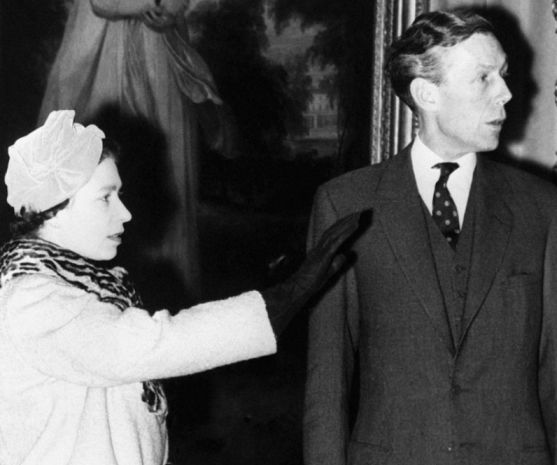
Edward VIII became King of England after his father's death, George V.
He ruled for less than a year, abdicating the throne in 1936 to marry Wallis
Simpson, an American divorcée (nazi spy). The Church
of England, led by the monarch, did not allow divorces at the time. Therefore,
not knowing she was working for had a choice: love or the crown. He chose to
marry Wallis Simpson.
We know that King Edward VIII, subsequent Duke of Windsor, was
initially influenced by his family members among the German aristocracy during the Nazi period, which
also led to Hitler's idea of an Anglo-German
collaboration.
Early on, Sir Anthony Rumbold, whose father was ambassador to Germany
from 1928 to 1933, tried to alert the British government about the rise of
groups like Oswald Mosley’s British Union of Fascists (BUF) that
claimed to have some 50,000 members in 1934.1 While Mosley’s BUF was noisy
and sometimes even violent, the undercurrents of British Fascism were more
widespread and nefarious, infiltrated by Hitler at the highest echelons of
British society. Hitler actively pursued an effective and largely overlooked
backdoor foreign policy with a less traditional spin.

Suspicious of his Foreign Ministry, Hitler recruited German aristocrats with close family ties across Europe.
After the destruction of the First World War, the royal families of Britain,
France, Belgium, Netherlands, Spain, Italy, Romania, and Germany were all
looking to seize a more visible political role in their respective countries.
Hitler understood early on the strength of this transnational elite, united and
emboldened by a fear of Communism and desperate to avoid the same violent end
as their cousins, the Russian czar, and his family. As Queen Marie of Romania
wistfully remarked, “Fascism, although also a tyranny, leaves scope for
progress, beauty, art, literature, home, and social life, manners, cleanliness,
whilst Bolshevism is the leveling of everything.” In the case of the British
aristocracy, fears of Communism were compounded by the first tremors of the
unraveling of the British Empire and their place at its vaulted helm.
By 1938, as German aggression in the Sudetenland became widely
anticipated, Chamberlain, known for
his Appeasement towards Hitler, spent a late March weekend at Cliveden House. Their visitors were also referred to
as the Cliveden Set. In between games of charades, the decision
was made to allow Germany to annex Czechoslovakia, a region of little strategic
importance to Britain and, therefore, an event not worthy of starting a second
world war.
In London, as we have seen, other hostesses
played high-profile roles in the pro-German circles. One was Lady
Londonderry, wife of the Marquess of Londonderry, holder since 1935 the office
of Lord Privy Seal, and another was Lady (Emerald) Cunard, another
American-born Englishwoman. Lady Cunard, the widow of Sir Bache Cunard,
maintained a literary and musical salon and was known as 'the Queen of Covent
Garden. In 1935 she was enthusiastic not only for Hitler but also for
Ambassador Ribbentrop, and it was said that she, through Wallis Simpson,
influenced the Prince of Wales to favor Germany. At the instigation of Lady
Cunard, the conductor, Sir Thomas Beecham, gave a concert in the Berlin
Philharmonic Hall, which Hitler attended. In 1936 Lord and Lady Londonderry
visited Hitler; in February 1937, she described Hitler as the symbol of the new
Germany, as its creator and a born leader, a captivating personality, and a man
who possessed the greatness 'to act in a perfectly normal way.' She was
convinced he was a guarantor of peace and friendship with the British. He had
preserved Germany from communism, and he alone “could be relied upon to save
Europe.”2
In April 1941, the Duke and Duchess of Windsor set sail on the SS
Berkshire from Nassau in the Bahamas to Florida. The former British king and
his new wife took one of the last regularly scheduled trips between Nassau and
the US mainland before the ship was requisitioned for US government use during
the war. Ostensibly, the purpose of the trip was a dentist appointment for
Wallis.
What emerges from this six-day trip, meticulously surveilled mainly
through J. Edgar Hoover at the request of President Franklin Roosevelt, reveals
the concerns the Americans and the British shared about the duke and duchess’s
complicity with the Nazi high command.
A deputy to the duke in the Bahamas claimed that the duke was afraid to
travel to Florida because he believed that he would be kidnapped by the Germans
and traded for Rudolf Hess, a leading member of the Nazi Party, who had landed
in Scotland in 1941 with the intent to make a deal with members of the British
government who sympathized with the Nazi regime to avoid a war between the two
countries.
The couple had arrived in the Bahamas on August 18, 1940, spirited away
on orders from Churchill from Nazi-controlled Madrid and Lisbon, where they
were lingering after Wallis grew “bored” with the South of France. According to
Nazi war plans, former ambassador to London and now foreign minister Joachim
von Ribbentrop had been plotting to reinstall Edward on the British throne as a
Nazi puppet, with Wallis as his queen. This end would be accomplished by
capitalizing on the Windsors’ established sympathy
for both Hitler and the Nazi regime.
Hitler had long sought an alliance with the British monarchy through a
union between the kings of England and the emperors of Germany. Earlier, he had
promoted the idea of a marriage between the Prince of Wales and Princess Friedericke, the seventeen-year-old daughter of Duke Ernst
August of Brunswick and Duchess Victoria Louise. The Duchess was horrified by
the idea of her young daughter marrying Edward, as she had been rumored to be
his potential wife.
As a choice for a wife, Wallis Simpson was equally unappealing to the
British royal family. Already twice married and American-born, Wallis Simpson
met Edward in 1932. She and her husband, Ernest Simpson, were invited to join a
shooting weekend at the Leicestershire home of Viscountess Thelma Furness and
her husband. Simpson’s financial pressures had already contributed to Wallis’s
roving eye. Soon after the weekend party, she invited the future king to dinner
at the Marylebone flat on George Street, 5 Bryanston
Court, that she shared with her husband. Wallis was a sought-after dinner party
hostess, her table a destination where some of the most influential names in
British society and right-wing politics, like Oswald Mosley, were frequent
guests. That January evening, the prince stayed until 4:00 A.M. as the
conversation drew him into a discussion of new ideas that were bubbling up
furiously in the world of Hitler, Mussolini, Stalin, and the New Deal. As the
duke would recall, Wallis was extraordinarily well informed, her conversation
deft and amusing.
By 1934, Wallis’s husband was suffering ever more remarkable business
reversals, which accelerated her pursuit of the duke. She was sufficiently
entrenched in Edward’s circle that Thelma Furness, leaving for an extended trip
overseas, met Wallis for tea at the Ritz Hotel before her departure and asked
Wallis to look after “her little man” in her absence. Returning a few months
later, Thelma wrote that Wallis had “looked after him exceedingly well.” The
resulting domestic situation, as Chips Channon, a diarist of the London beau
monde, noted, was the “ménage Simpson.”
Wallis had a wandering eye, and Edward was not the only opportunity she
entertained. Joachim von Ribbentrop, who presented his credentials as German
ambassador to the Court of St. James’s in June 1936, also sparked her
attention. Ribbentrop arrived in London with much fanfare, viewing his role as
a public relations opportunity at the Foreign Office, whose legions were
skeptical of Hitler. One fellow diplomat commented that Ribbentrop was an
excellent choice for the Court of St. James’s job, suggesting that he enjoyed
the company of prominent people.
Ribbentrop’s approval for the post of ambassador was accelerated
through the usual vetting process, with relief that the German government had
not only filled the vacancy but with somebody well known and seemingly
well-liked by them. Foreign Minister Anthony Eden had discussed the newly
proposed German ambassador with the king. “Herr von Ribbentrop is so well known
already it is perhaps unnecessary to give you the usual details about him,”
especially since the secretary of state was recommending that Ribbentrop be
accepted that same day for an official announcement to be made before Eden went
out of town at the end of the week. When Ribbentrop presented his credentials
to King George VI in early February, his resonating greeting of “Heil Hitler”
was criticized even by Goering, who later said that “because of that stupid
tactlessness,” he had risked becoming “persona non grata” with the British. Ribbentrop
may have brought controversy with him to Britain, but the British government
was willing to overlook it. A brief memo written by Eden marked “Personal” to
“Your Excellency” on the topic of Ribbentrop in November 1936 further revealed
his determination to safeguard Ribbentrop’s position in London. The memo
suggested that no action be taken on an unnamed matter relating to Ribbentrop
“since such action must inevitably result in further publicity and controversy.
I am sure this is the last thing we desire.”
In Edward, Ribbentrop had an easy mark. Over the years, the duke spoke
fondly of his German ancestry, proclaiming to Diana Mitford that “every drop of
blood in my veins is German.” Diana Mitford Mosley recalled Edward mentioning
that the royal family would wait until their guests left a gathering, at which
point the family “comfortably lapsed into German.” It was widely reported that
the duke considered German his mother tongue and corresponded with his extended
German family “Auf Deutsch.” One cousin reported that after a trip to Germany
in 1935, the future king took to “wearing a German helmet and goose-stepping
around the living room, for what reason I cannot imagine.” In his defense,
another friend remarked that since England had cut him off after he abdicated
the throne, it was only natural that he would pivot toward Germany, with which
he had always felt a great affinity.
Hitler, in turn, saw an opportunity in Edward as heir to the throne. As
early as 1936, Hitler was reported to be watching newsreels of the future king
before the funeral of George V. To represent Germany, Hitler again sent Carl
Eduard, Duke of Saxe, and Coburg, a first cousin of the deceased king. This was
one of ten trips that Saxe and Coburg made to England on Hitler’s behalf during
the period leading up to Britain’s entry into the war.
The fact that Edward was forced to abdicate the throne to marry Wallis
attracted the interest of the German regime. Rumors about his pro-German
sentiments quickly circulated among the Nazi Party. The former Austrian
ambassador to England, Count Albert von Mensdorff,
reported that the duke was interested in returning to the throne if the Germans
successfully invaded England, a development that he found “interesting and
significant.” As the duke planned his wedding to Wallis in Paris in June 1937,
the British ambassador, Eric Phipps, cabled the Foreign Office speculating
about the duke’s plans: the duke “seems to be rather embarrassed by the
excessive attentions of the French, and compares their behavior unfavorably
with the discretion with which he was treated in Austria.” In his memoir,
Albert Speer, the architect of the 1936 Olympic Stadium and other Fascist Nazi
landmarks, wrote about the duke's role in the Nazi regime: “I am certain that
through him permanent friendly relations with England could have been achieved.
If he had stayed, everything would have been different. His abdication was a
severe loss for us.”
Another British diplomat, Sir Robert Lockhart, noted in his diary after
meeting Edward at St. James’s Palace that “the Prince of Wales was quite
pro-Hitler and said it was no business of ours to interfere in Germany’s
internal affairs, either re Jews or re anything else and added that dictators
are very popular these days and we might want one in England before long.”
Ribbentrop also quickly recognized the advantages of the duke’s pro-German
position and was eager to exploit it: “I am convinced his (Edward’s) friendly
disposition towards Germany will have some influence on the formation of
British foreign policy.”
Ribbentrop’s ambassadorship had all the hallmarks of great success, a
sworn allegiance and backing of Hitler, and a popular choice at the Court of
St. James’s. He also had the advantage of social charms cultivated and appreciated
by the British aristocracy. As the German diplomat Paul Schwarz recounted,
“Ribbentrop was a snob with a vengeance. To twist his stomach with caviar in
the presence of the Duke of Devonshire or the American Ambassador, he would
walk more than a mile. . . . There is no genuine trait in him.”
Ribbentrop saw an opportunity to infiltrate the heart of British
tradition and political power through the Duke of Windsor. His first line of
approach was through Wallis Simpson. Ribbentrop met Wallis through another
American society hostess, Lady Emerald Cunard. He was a guest of honor at a
dinner at her home on Grosvenor Square in June 1935. The two met privately
again soon after. Ribbentrop sent Wallis seventeen carnations daily, delivered
to her flat in Bryanston Court by a shop attendant.
These carnations and her affair with Ribbentrop quickly became the main topic
of conversation at the German embassy. Wallis was in “constant contact” with
von Ribbentrop. In practice, “the Duchess was obtaining a variety of information
concerning the British and French government official activities that she was
passing on to the Germans.”
As Ribbentrop infiltrated the Windsors’ close
circle, sensitive information about England began to leak into German
diplomatic circles. One German diplomat pointed a finger not only at Edward but
at Wallis’s access to her husband’s papers. Berlin was filled with loose talk
about Edward. It was said that he neglected his duties in handling official
documents. Secret Ambassadorial reports were especially emphasized. At Fort
Belvedere, the Foreign Office dispatch bags were said to have been left open,
and official secrets might have leaked out. Was it not true that in Nazi
Berlin, one could hear stories that London passed for State Secrets? Undoubtedly,
some people in official British circles were aware that these rumors cast an
unwanted reflection upon their King.
While there are both German and American files about the wartime
activities of the Duke and Duchess of Windsor, only the British held a copy of
a German file innocuously labeled as “Matters relating to the Royal Household
1940–66.” This includes a top-secret file dated August 24, 1953, containing the
German correspondence relating to the Nazi plan for the Duke and Duchess of
Windsor during their stay in Madrid and Lisbon during the summer of 1940.
One of the duke and duchess’s first trips as a married couple was to
Germany. Sir W. Selby, British ambassador to Germany, wrote to Ambassador Eric
Phipps in Paris, where the Duke and Duchess had set up residence, that he had
received “a letter dated September 20th from the Duke of Windsor informing me
that he and the Duchess are visiting Germany shortly ‘to see what is being done
to improve working and living conditions of laboring classes in several of the
larger cities.’” Selby wanted Phipps to tell the duke that he would not be in
Germany during the proposed dates, hoping that might head off an awkward visit
by a former monarch with suspicious political allegiances.
Ambassador Phipps then updated Foreign Secretary Anthony Eden in a
cipher telegram noting that “His Royal Highness told me he was leaving for
Berlin on October 7th and expects to stay there for a couple of days. After
that, he will travel about in Germany; he does not quite know where, and will
study housing and working conditions there. I warned his Royal Highness that
the Germans were past masters in the art of propaganda and that they would be
quick to turn anything he might say or do to suit their purposes. He assured me
he was well aware of this, that he would be cautious and not make any
speeches.”
News of the duke and duchess’s trip also came through the “private
channels” of the British embassy in Berlin. Cables exchanged between the
various British consulates lamented the breach of diplomatic protocol in that
the Reich command had organized the trip without consultation with the British
embassy and confirmed that “Germany would pay all costs of the trip.”
As a conclusion to Part One, we can say that Hitler’s aristocrats, figuratively
speaking became his eyes, listening posts, and mouthpieces in the drawing
rooms, cocktail parties, and weekend retreats of Europe and America. They were
the trusted voices disseminating his political and cultural propaganda about
New Germany, brushing aside the Nazis’ atrocities. Distrustful of his Foreign
Ministry, Hitler used his aristocrats to open the right doors and, as we will
see in parts two to four created a formidable fifth column within government
and financial circles. As we will see, there were also three conspiracies
intended to stage a coup d’état to be led by a coalition of British
fascist groups, which had been under consideration within the wider British
fascist movement in the weeks immediately after the war was declared.
1. Andrzej Olechnowicz, ‘Liberal Anti-Fascism in the 1930s: The Case
of Sir Ernest Barker, in Albion: A Quarterly Journal Concerned with British
Studies 36 (2004), 636– 60, here 643. On the British Union of Fascists more
generally, see Martin Pugh, ‘Hurrah for the Blackshirts!’:
Fascists and Fascism in Britain between the Wars (London: Pimlico, 2006).
2. See Ian Kershaw, Making Friends With Hitler: Lord
Londonderry, the Nazis, and the Road to War II, 2004.
Mosley's, which borrowed from Nazi German Fascism.
Oswald Mosley’s British Union of Fascists claimed to
have some 50,000 members at the peak of its popularity in 1934.
3. Andrzej Olechnowicz, ‘Liberal Anti-Fascism in the 1930s: The Case
of Sir Ernest Barker’, in Albion: A Quarterly Journal Concerned with British
Studies 36 (2004), 636– 60, here 643. On the BUF more generally, see Martin
Pugh, ‘Hurrah for the Blackshirts!’: Fascists and
Fascism in Britain between the Wars (London: Pimlico, 2006).
For updates click hompage here